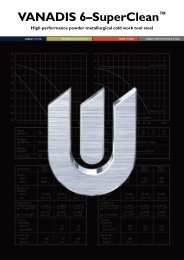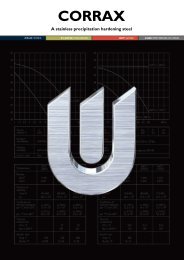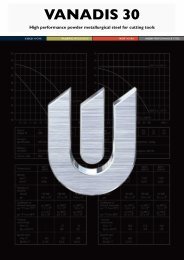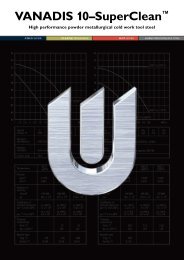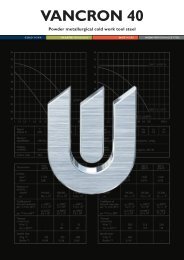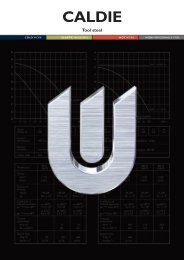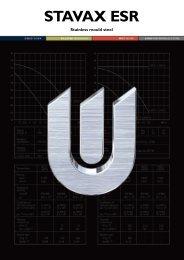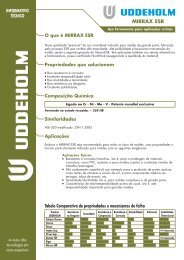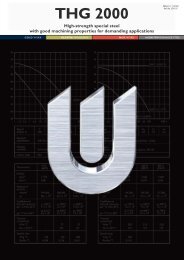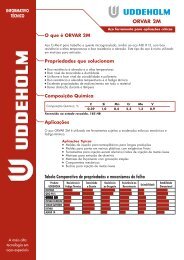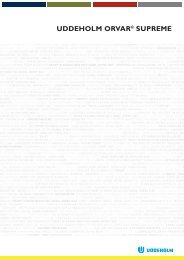SLEIPNER - Uddeholm
SLEIPNER - Uddeholm
SLEIPNER - Uddeholm
Create successful ePaper yourself
Turn your PDF publications into a flip-book with our unique Google optimized e-Paper software.
<strong>SLEIPNER</strong><strong>SLEIPNER</strong>Cold work tool steel1
<strong>SLEIPNER</strong>This information is based on our present state of knowledge and isintended to provide general notes on our products and their uses. It shouldnot therefore be construed as a warranty of specific properties of theproducts described or a warranty for fitness for a particular purpose.2
<strong>SLEIPNER</strong>General<strong>SLEIPNER</strong> is a chromium-molybdenum-vanadiumalloyed tool steel which is characterised by:• Good wear resistance• Good chipping resistance• High compressive strength• High hardness (>60 HRC) after high temperaturetempering• Good through-hardening properties• Good stability in hardening• Good resistance to tempering back• Good WEDM properties• Good machinability and grindability• Good surface treatment properties.Typical analysis %Standard spec. NoneDelivery conditionColour code Blue/brownApplicationsSoft annealed to approx. 235 HB<strong>SLEIPNER</strong> is a general purpose steel for cold worktooling. It has a mixed-abrasive wear profile and agood resistance to chipping. Furthermore a highhardness (>60 HRC) can be obtained after hightemperature tempering. This means that surfacetreatments such as nitriding or PVD can be made ona high strength substrate. Also, it means thatcomplicated shapes with hardness levels >60 HRCcan be wire EDM’d from blocks with relatively thickcross-sections with a much reduced risk of cracking.<strong>SLEIPNER</strong> is recommended for medium run toolingapplications where a resistance to mixed orabrasive wear and a good resistance to chipping arerequired.Examples:• Blanking and fine blanking• Shearing• Forming• Coining• Cold forging• Cold extrusion• Thread rolling• Drawing and deep drawing• Powder pressingC Si Mn Cr Mo V0,9 0,9 0,5 7,8 2,5 0,5PropertiesPHYSICAL DATAHardened and tempered to 62 HRC. Data at roomand elevated temperatures.Temperature 20°C 200°C 400°C(68°F) (390°F) (750°F)Densitykg/m 3 7 730 7 680 7 620lbs/in 3 0,279 0,277 0,275Modulus of elasticityMPa 205 000 190 000 180 000ksi 297 000 276 000 261 000Coefficient ofthermal expansion–after low temperaturetempering (60 HRC)per °C from 20°C – 12,7 x 10 –6 –per °F from 68°F – 7,1 x 10 –6 ––after high temperaturetemperingper °C from 20°C – 11,6 x 10 –6 12,4 x 10 –6per °F from 68°F – 6,4 x 10 –6 6,9 x 10 –6Thermal conductivityW/m•°C – 20 25Btu in/(ft 2 h °F) – 140 170Specific heatJ/kg C 460 – –Btu/lb. °F 0,11 – –COMPRESSIVE STRENGTHThe figures should be considered as approximate.HardnessCompressive yield strength Rc0,2HRC MPa ksi50 1 700 25055 2 050 30060 2 350 34062 2 500 36064 2 650 380CHIPPING RESISTANCERelative chipping resistance for SVERKER 21,<strong>SLEIPNER</strong> and RIGOR at the same hardness level.Relative chipping resistance1,751,501,251,000,750,500,25SVERKER 21 <strong>SLEIPNER</strong> RIGOR3
<strong>SLEIPNER</strong>ABRASIVE WEAR RESISTANCERelative abrasive wear resistance for SVERKER 21<strong>SLEIPNER</strong> and RIGOR at the same hardness level(low value means better wear resistance).Relative abrasive wear rate1,21,00,80,60,40,2RIGOR <strong>SLEIPNER</strong> SVERKER 21Heat treatmentSOFT ANNEALINGProtect the steel and heat through to 850°C(1560°F). Then cool in the furnace at 10°C (20°F)per hour to 650°C (1200°F), then freely in air.STRESS RELIEVINGAfter rough machining the tool should be heatedthrough to 650°C (1200°F) and held for 2 h. Coolslowly to 500°C (930°F) then freely in air.HARDENINGPreheating temperature: 650–750°C (1200–1380°F)Austenitizing temperature: 950–1080°C (1740–1980°F) but usually 1030–1050°C (1890–1920°F)Holding time: 30 minProtect the part against decarburization andoxidation during hardening.QUENCHING MEDIA• Forced gas/circulating atmosphere• Vacuum (high speed gas with sufficientoverpressure)• Martempering bath or fluidized bed at 500–550°C (930–1020°F)• Martempering bath or fluidized bed at approx.200–350°C (390–660°F)• Oil (only very simple geometries)Note: Temper the tool as soon as its temperaturereaches 50–70°C (120–160°F)Hardness, retained austenite and grain size asfunction of austenitizing temperatureGrain Hardness HRCsize67ASTM661065864663462261Grain sizeHardnessRetained austeniteRetained austenite %35600975 1000 1025 1050 1075 1100Austenitizing temperature °C (30 min)TEMPERINGChoose the tempering temperature according to thehardness required by reference to the temperinggraph. Temper at least twice with intermediatecooling to room temperature. The lowest temperingtemperature which should be used is 180°C (360°F).The minimum holding time at temperature is 2 h.30252015105Hardness, HRC70Retained austenite %706560Hardness6050551075°C/30 min.1050°C/30 min.40503045Retained austenite20401030°C/30 min.1035150 200 250 300 350 400 450 500 550 600 650 700Tempering temperature °C, (2h + 2h)04
<strong>SLEIPNER</strong>TTT-graphAustenitizing temperature 1030°C (1890°F). Holding time 30 min.°C11001000Austenitizing temperature 1030°CHolding time 30 min.900Ac 1f= 880°C800700CarbidesPearliteAc 1s= 830°CTemp. Time Hardness°C. h2 HV10600500400300200100MartensiteBainite800 31,0 498750 3,1 266725 1,6 309700 3,0 304650 19,6 239600 23,3 724300 7,0 813250 16,3 803200 23,4 813Seconds1 10 100 1 000 10 000 100 000 SecondsMinutes1 10 100 1 000 MinutesHours1 10 100 HoursCCT-graphAustenitizing temperature 1030°C (1890°F). Holding time 30 min.°C11001000Austenitizing temperature 1030°CHolding time 30 min.900Ac 1f= 880°C800700600500400300200100M sCarbidesMartensitePearliteBainite1 2 3 4 5 6 7 81 10 100 1 000 10 000 100 000 Seconds1 10 100 1 000 Minutes1 10 100 Hours0.2 1.5 10 90 6009Ac 1s= 830°CSecondsMinutesHoursAircoolingAir cooling ofof bars, Ø mm Ø mmCoolingcurve Hardness *T 800–500no. HV 10 (sec.)1 824 22 824 113 813 1404 813 2805 813 6306 813 12417 724 24828 649 52159 572 83605
<strong>SLEIPNER</strong>DIMENSIONAL CHANGESThe dimensional changes have been measured afteraustenitizing and tempering.Austenitizing: 1030°C (1890°F)/30 min, cooling invacuum furnace at 0,75°C/s (1,35°F/s) between800°C (1470°F) and 500°C (930°F)Tempering: 2 x 2 h at various temperaturesSpecimen size: 100 x 100 x 100 mmDimensional changes as function of temperingtemperatureDimensional changes %+0,15+0,10+0,050–0,05–0,10LengthWidthThickness200 300 400 500 600Tempering temperature °CSUB-ZERO TREATMENTPieces requiring maximum dimensional stabilityin service should be sub-zero treated. Sub-zerotreatment reduces the amount of retained austeniteand changes the hardness as shown in the diagrambelow:Austenitizing: 1030°C (1890°F)/30 minTempering: 2 x 2 h at various temperaturesSurface treatmentsSome cold work tool steels are given a surfacetreatment in order to reduce friction and increasewear resistance. The most commonly used treatmentsare nitriding and surface coating with wearresistant layers produced via PVD or CVD.The high hardness and good resistance to chippingtogether with a good dimensional stability make<strong>SLEIPNER</strong> suitable as a substrate steel for varioussurface coatings.NITRIDING AND NITROCARBURIZINGNitriding and nitrocarburizing result in a hard surfacelayer which is very resistant to wear and galling.The surface hardness after nitriding is approximately1100 HV 0,2kg . The thickness of the layershould be chosen to suit the application in question.PVDPhysical vapour deposition, PVD, is a method ofapplying a wear-resistant coating at temperaturesbetween 200–500°C (390–930°F).CVDChemical vapour deposition, CVD, is used for applyingwear-resistant surface coatings at a temperatureof around 1000°C (1830°F). It is recommended thatthe tools are separately hardened and tempered ina vacuum furnace after surface treatment.Hardness and retained austenite as function oftempering temperature and sub-zero treatmentno treatmentsub-zero treatmentHardness HRC7570656055504540HardnessRetained austeniteRetained austenite %2421181512963351500250 350 450 550 650Tempering temperature °C6
<strong>SLEIPNER</strong>MachiningrecommendationsThe cutting data below are to be considered asguide values which must be adapted to existinglocal conditions.More information can be found in the <strong>Uddeholm</strong>publication ”Cutting data recommendation”.Condition: Soft annealed to approx. 235 HB.TURNINGDRILLINGHigh speed steel twist drillCuttingDrill diameter speed (v c ) Feed (f)mm inch m/min f.p.m. mm/rev i.p.r.– 5 –3/16 13–18* 43–59* 0,05–0,10 0,002–0,0045–10 3/16–3/8 13–18* 43–59* 0,10–0,20 0,004–0,00810–15 3/8–5/8 13–18* 43–59* 0,20–0,25 0,008–0,01015–20 5/8–3/4 13–18* 43–59* 0,25–0,30 0,010–0,0121)For coated HSS drill v c 25–35 m/min. (82–115 f.p.m./min.)Carbide drillTurning withcarbideTurningwith highspeed steelCutting data Rough Fine Fineparameters turning turning turningCutting speed (v c )m/min. 100–150 150–200 17–22f.p.m. 328–492 492–656 56–72Feed, (f)mm/rev 0,2–0,4 0,05–0,2 0,05–0,3i.p.r. 0,008–0,016 0,002–0,008 0,002–0,01Depth of cut, (a p )mm 2–4 0,5–2 0,5–3inch 0,08–0,16 0,02–0,08 0,02–0,12CarbidedesignationISO K20, P20 K10, P15 –US C2–C6 C3, C7 –Coated Coatedcarbide carbideType of drillCutting data Indexable Solide Brazedparameters insert carbide carbide 1)Cuttingspeed (v c )m/min 140–160 80–100 45–55f.p.m. 460–525 262–328 148–180Feed (f)mm/r 0,05–0,15 2) 0,10–0,25 2) 0,15–0,25 2)i.p.r 0,002–0,006 2) 0,004–0,01 2) 0,006–0,01 2))MILLINGFace and square shoulder millingMilling with carbideCutting data Rough Fineparameters milling millingCutting speed (v c )m/min 110–180 180–220f.p.m. 360–590 590–722Feed (f z )mm/tooth 0,2–0,4 0,1–0,2inch/tooth 0,008–0,016 0,004–0,008Depth of cut (a p )mm 2–5 –2inch 0,08–0,2 –0,08Carbide designationISO K20, P20 P10–P20US C2, C6 C3–C7Coated carbide Coated carbideEnd millingType of millingCarbideCutting data Solide indexable High speedparameters carbide insert steelCuttingspeed (v c )m/min 80–120 100–140 13–18 1)f.p.m. 262–394 328–460 43–59 1)Feed (f z )mm/tooth 0,006–0,20 2) 0,06–0,20 2) 0,01–0,35 2)inch/tooth 0,0002–0,008 2) 0,002–0,008 2) 0,0004–0,014 2)CarbidedesignationISO K10, P40 P15–P40 –US C3, C5 C6–C5 –1)For coated HSS end mill v c 30–35 m/min. (98–115 f.p.m. min.)2)Depending on radial depth of cut and cutter diameter.GRINDINGA general grinding wheel recommendation is givenbelow. More information can be found in the<strong>Uddeholm</strong> publication ”Grinding of tool steel”.Wheel grindingSoft annealed HardenedType of grinding condition conditionFace grindingstraight wheel A 46 HV A 46 GVFace grinding segments A 24 GV A 36 GVCylindrical grinding A 46 LV A 60 KVInternal grinding A 46 JV A 60 IVProfile grinding A 100 LV A 120 JV1)Drill with internal cooling channels and brazed tip.2)Depending on drill diameter.7
<strong>SLEIPNER</strong>WeldingGood results when welding tool steel can beachieved if proper precautions are taken during thewelding operation.• The joints should be prepared properly.• Repair welds should be made at elevated temperature.Make the two first layers with thesame electrode diameter and/or current.• Always keep the arc length as short as possible.The electrode should be angled at 90° to thejoint sides to minimize undercut. In addition,the electrode should be held at an angle of75–80° to the direction of forward travel.• For large repairs, weld the initial layers with asoft filler material (buffering layer)FILLER MATERIALTIG Welding consumablesFiller MaterialType AWS ER312UTP A67SUTP A696CastoTig 5*Hardness after welding300 HB (for buffering layers)55–58 HRC60–64 HRC60–64 HRC* Should not be used for more then 4 layers because of theincreased risk of crackingMMA (SMAW) Welding consumablesFiller MaterialType AWS E312CASTOLIN 2UTP 67SUTP 69CASTOLIN 6Hardness after welding300 HB (for buffering layers)54–60 HRC55–58 HRC60–64 HRC60–64 HRCPREHEATING TEMPERATUREThe temperature of the tool during the entire weldingprocess should be maintained at an even level.HEAT TREATMENT AFTER WELDINGSoft annealedHardenedHardness 230 HB 60–62 HRCCooling rate 20–40°C/h for the first 2 hoursthen freely in airHeattreatment Soft anneal Temper 10–20°CHardenbelow the latestTemper tempering temperatureMore information on welding of tool steel can befound in the <strong>Uddeholm</strong> publication ”Welding of ToolSteel”.Flame hardeningUse oxy-acetylene equipment with a capacity of800–1250 l/h. Oxygen pressure 2,5 bar, acetylenepressure 1,5 bar. Adjust to give neutral flame.Temperature: 980–1020°C. Cool freely in air.The hardness at sthe surface will be 58–62 HRC and41 HRC (400 HB) at a depth of 3–3,5 mm.Electrical-dischargemachining–EDMIf EDM is performed in the hardened and temperedcondition, finish with a fine-sparking, i.e. low current,high frequency.For optimal performance the EDM’d surface shouldbe ground/polished and the tool re-tempered atapprox. 25°C (80°F) lower than the original temperingtemprature.When EDM’ ing larger sizes or complicated shapes<strong>SLEIPNER</strong> should be tempered at high temperature,above 500°C (930°F).Soft annealed HardenedHardness 230 HB 60–62 HRCPreheatingtemperature 250°C 250°CMax. interpasstemperature400°C 400°C8
<strong>SLEIPNER</strong>Relative comparisonof <strong>Uddeholm</strong> cold work tool steelMATERIAL PROPERTIES AND RESISTANCE TO FAILURE MECHANISMSHardness/ Resistance to Fatigue cracking resistanceResistance Ductility/ Toughness/<strong>Uddeholm</strong> to plastic Machin- Grind- Dimension Abrasive Adhesive resistance to grossgrade deformation ability ability stability wear wear chipping crackingARNE ARNECALMAX CALMAXRIGOR<strong>SLEIPNER</strong>SVERKER 21 21SVERKER 3 3VANADIS 4VANADIS 6VANADIS 10VANADIS 23Further informationPlease contact your local <strong>Uddeholm</strong> office forfurther information on the selection, heat treatment,application and availability of <strong>Uddeholm</strong> tool steel.9



